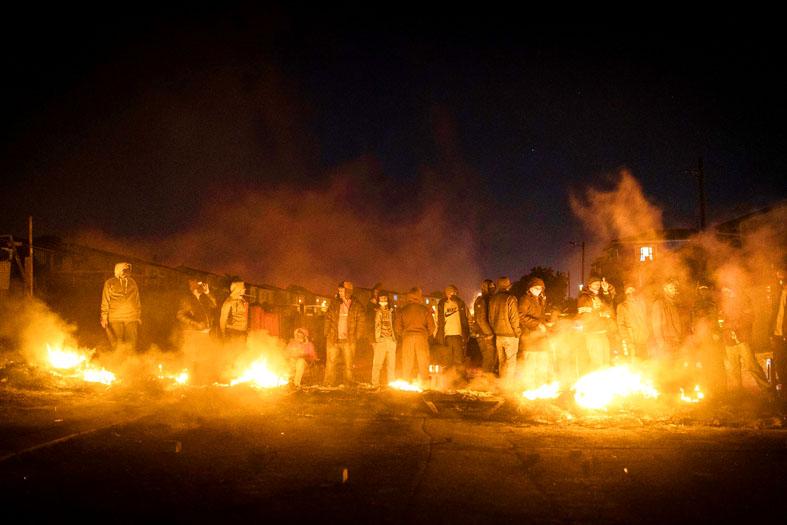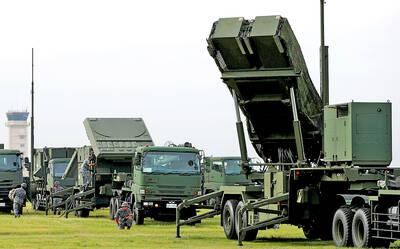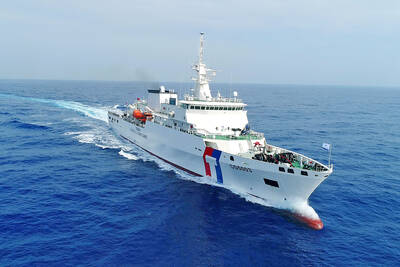South Africa’s death toll from days of riots on Thursday rose to 117 even as the worst of the violence appeared to ease, with the deployment of thousands of soldiers starting to take effect.
Authorities have arrested almost 1,500 people, including 12 who allegedly instigated the unrest, resulting in rampant looting and the destruction of businesses in two key provinces, South African Acting Minister in the Presidency Khumbudzo Ntshavheni told reporters in Pretoria.
The situation remains volatile in KwaZulu-Natal province, the heart of the violence, while the economic hub of Gauteng should stabilize soon, she said.

Photo: AFP
About 10,000 troops are now on the streets, leading to a drop in the number of incidents.
“These are not demonstrations, this is economic sabotage,” Ntshavheni said.
Protests erupted on Saturday last week after former South African president Jacob Zuma was imprisoned for defying a court order, before spiraling out of control as marauding mobs began to loot stores, banks and medical facilities.
The rising death count represents the most lethal uprising since the buildup to the end of apartheid in 1994, when violent demonstrations and subsequent crackdowns were relatively commonplace.
Telecommunications towers and other infrastructure have been destroyed, while transport networks and a program to vaccinate people against COVID-19 have been disrupted.
Business Leadership South Africa, one of the country’s main business lobby groups, estimates that damages amount to more than 5 billion rand (US$343 million) for the retail industry alone.
More than 200 shopping malls were targeted, more than 800 stores were looted, and 100 were completely burnt, the group’s chief executive officer, Busi Mavuso, told Bloomberg via e-mail.
Attention is now turning to whether insurance companies will be able to cover the cost of the carnage, with claims estimated to run up to several billions of rand.
The sheer number of affected businesses means that it is likely that processing claims would be slow and an interim fund might have to be set up for support, said Martin Kingston, an official at Business Unity South Africa, another industry group, which is calling for a rolling 24-hour curfew in the key provinces and a full deployment of the South African military to bring an end to the crisis.
“It will take two to three years to recover the infrastructure lost here,” former Goldman Sachs Group Inc. Sub-Saharan Africa chairman Colin Coleman said. “To restock these centers will take 10 weeks, and we are going to have severe shortages for some time.”
Some groups have urged South African President Cyril Ramaphosa to give the police and military additional powers to end the violence, fearing that communities and private militias would mete out their own forms of justice.
Video footage published on Johannesburg-based radio station Kaya 959’s Web site showed private security guards firing live ammunition at a mob on Tuesday.
“I really would like to see our president talking to people, and giving a level of affirmation and confidence,” Investec PLC chief executive officer Fani Titi said. “At this point in time, we need much firmer communication.”

MILITARY BOOST: The procurement was planned after Washington recommended that Taiwan increase its stock of air defense missiles, a defense official said yesterday Taiwan is planning to order an additional four PAC-3 MSE systems and up to 500 missiles in response to an increasing number of missile sites on China’s east coast, a defense official said yesterday. The official, who spoke on condition of anonymity, said that the proposed order would be placed using the defense procurement special budget, adding that about NT$1 trillion (US$32,88 billion) has been allocated for the budget. The proposed acquisition would include launchers, missiles, and a lower tier air and missile defense radar system, they said The procurement was planned after the US military recommended that Taiwan increase

POLITICAL AGENDA: Beijing’s cross-strait Mid-Autumn Festival events are part of a ‘cultural united front’ aimed at promoting unification with Taiwan, academics said Local authorities in China have been inviting Taiwanese to participate in cross-strait Mid-Autumn Festival celebrations centered around ideals of “family and nation,” a move Taiwanese academics said politicizes the holiday to promote the idea of “one family” across the Taiwan Strait. Sources said that China’s Fujian Provincial Government is organizing about 20 cross-strait-themed events in cities including Quanzhou, Nanping, Sanming and Zhangzhou. In Zhangzhou, a festival scheduled for Wednesday is to showcase Minnan-language songs and budaixi (布袋戲) glove puppetry to highlight cultural similarities between Taiwan and the region. Elsewhere, Jiangsu Province is hosting more than 10 similar celebrations in Taizhou, Changzhou, Suzhou,

TWO HEAVYWEIGHTS: Trump and Xi respect each other, are in a unique position to do something great, and they want to do that together, the US envoy to China said The administration of US President Donald Trump has told Chinese President Xi Jinping (習近平) “we don’t want any coercion, but we want [the Taiwan dispute] resolved peacefully,” US ambassador to China David Perdue said in a TV interview on Thursday. Trump “has said very clearly, we are not changing the ‘one China’ policy, we are going to adhere to the Taiwan Relations Act, the three communiques and the ‘six assurances’ that were done under [former US president Ronald] Reagan,” Perdue told Joe Kernen, cohost of CNBC’s Squawk Box. The act, the Three Joint Communiques and the “six assurances” are guidelines for Washington

DEEPENING TIES: The two are boosting cooperation in response to China’s coercive actions and have signed MOUs on search-and-rescue and anti-smuggling efforts Taiwan and Japan are moving to normalize joint coast guard training and considering the inclusion of other allies, the Japanese Yomiuri Shimbun reported yesterday. Both nations’ coast guards in June sent vessels to the seas south of the Sakishima Islands to conduct joint training, the report said, adding that it was the second joint maritime training exercise since the nations severed formal diplomatic ties in September 1972. Japan dispatched the Nagoya Coast Guard’s Mizuho, a 134m, 6,000-tonne patrol vessel which can carry a helicopter, while the Coast Guard Administration (CGA) sent the 126m, 4,000-tonne Yunlin, one of its largest vessels, the report